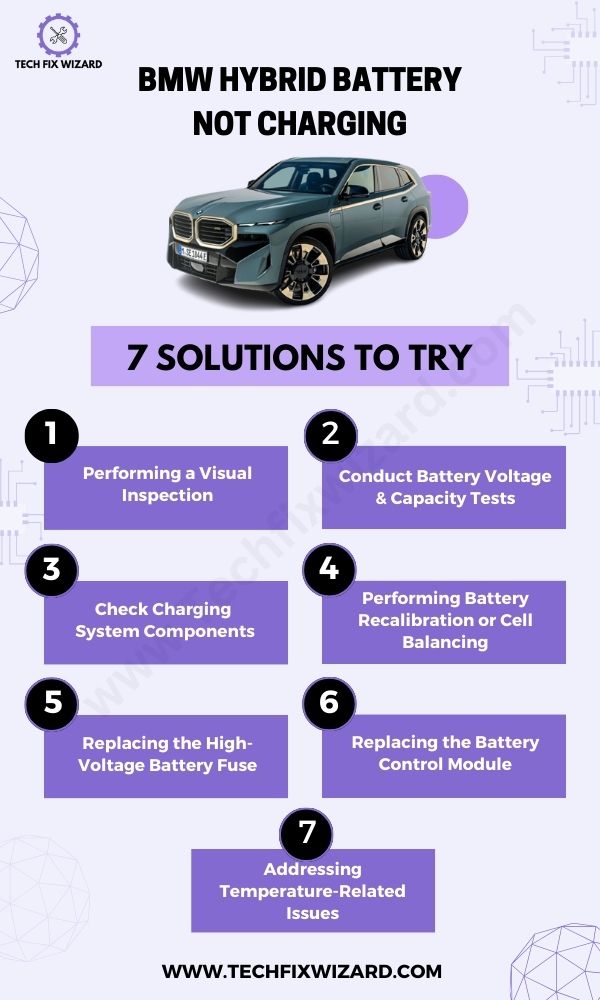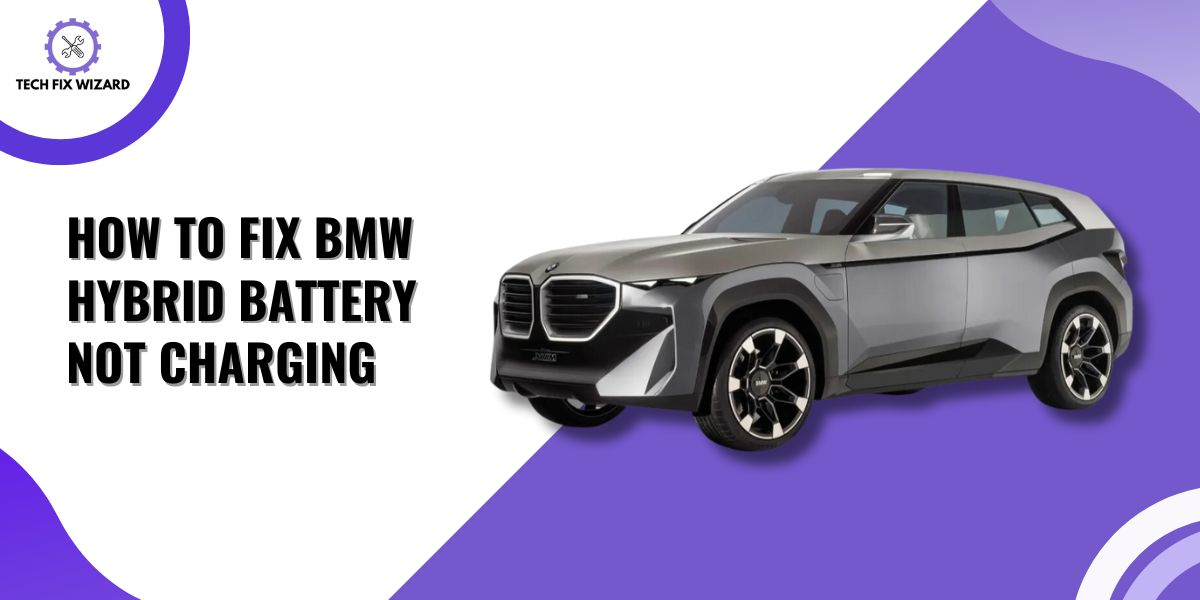Experiencing a BMW hybrid battery not charging issue can be a cause for concern, as it affects the performance and efficiency of your vehicle.
Hybrid vehicles rely on a well-functioning battery system to power the electric motor and provide eco-friendly driving capabilities.
However, when the hybrid battery fails to charge properly, it can lead to decreased electric range and reduced fuel efficiency.
In this article, we will discuss potential solutions to restore optimal performance and charging functionality in your vehicle.
Contents
- 1 BMW Hybrid Battery Not Charging – 7
- 2 Troubleshooting Steps
- 3 1. Performing a Visual Inspection
- 4 2. Conduct Battery Voltage and Capacity Tests
- 5 3. Check Charging System Components
- 6 4. Performing Battery Recalibration or Cell Balancing
- 7 5. Replacing the High-Voltage Battery Fuse
- 8 6. Replacing the Battery Control Module
- 9 7. Addressing Temperature-Related Issues
- 10 Preventing Future Battery Charging Issues
- 11 FAQs
- 12 How long does a BMW hybrid battery typically last before needing replacement?
- 13 Can a BMW hybrid battery be reconditioned or refurbished instead of replaced?
- 14 What is the cost of replacing a BMW hybrid battery?
- 15 Is it safe to drive a BMW hybrid with a faulty battery?
- 16 Are there any known recalls or warranty extensions for BMW hybrid battery issues?
- 17 Why is my BMW hybrid battery not charging?
- 18 Are there any specific warning signs to look out for indicating a battery charging issue?
- 19 Official References & Resources
BMW Hybrid Battery Not Charging – 7
Troubleshooting Steps
When encountering the issue of a BMW hybrid battery not charging, it’s important to follow a systematic troubleshooting approach to identify and resolve the underlying problem.
By taking the time to go through a series of diagnostic steps, you can pinpoint the root cause of the charging issue and determine the most effective solution.

Also Read: BMW Battery Not Charging Warning – 6 Troubleshooting Steps
1. Performing a Visual Inspection
The first step in troubleshooting a BMW hybrid battery not charging issue is performing a visual inspection.
This essential step allows you to visually assess the condition of the battery connections and components
– Inspect battery connections for corrosion, loose connections, or damage:
- Check the battery terminals for any signs of corrosion, which appear as white or greenish deposits. Corrosion can hinder the electrical connection and lead to charging issues.
- Ensure that the battery terminals are securely fastened to the corresponding cables. Loose connections can result in poor electrical contact and prevent proper charging.
- Examine the battery cables for any damage, such as fraying or exposed wires. Damaged cables can impede the flow of electricity and affect the charging process.
– Check for any visible damage or wear on battery components:
- Inspect the battery housing for cracks, leaks, or swelling. These can indicate internal battery damage or a faulty cell, which can disrupt the charging process.
- Look for any signs of physical damage or wear on the battery casing, such as dents or punctures. External damage can compromise the battery’s integrity and functionality.
- Ensure that the battery venting system is clear and free from obstructions. Proper ventilation is crucial to prevent overheating and ensure optimal battery performance.
2. Conduct Battery Voltage and Capacity Tests
Conducting battery voltage and capacity tests is an important diagnostic step when troubleshooting a BMW hybrid battery not charging issue.
These tests provide valuable information about the battery’s condition and help identify any underlying issues.
– Measure the voltage of the hybrid battery using a multimeter:
- Use a multimeter set to the DC voltage measurement mode.
- Carefully connect the multimeter probes to the positive (+) and negative (-) terminals of the hybrid battery.
- Read and note the voltage displayed on the multimeter. The reading should indicate the current voltage level of the battery.
– Evaluate the battery’s capacity to ensure it is within the specified range:
- Battery capacity refers to the amount of charge the battery can store and deliver. It is typically measured in ampere-hours (Ah) or kilowatt-hours (kWh).
- Consult the vehicle’s manual or specifications to determine the expected battery capacity range.
- If available, use specialized battery testing equipment or consult a professional to assess the battery’s capacity accurately.
Also Read: BMW Not Charging Battery – 6 Causes & Solutions
3. Check Charging System Components
The third step in troubleshooting a BMW hybrid battery not charging issue is to check the charging system components.
This step involves inspecting the charger, inverter, and cables for any signs of damage or malfunction.
– Inspect the charger, inverter, and cables for any signs of damage or malfunction:
- Examine the charger for physical damage, loose connections, or burnt components. Damaged chargers can hinder the proper charging of the hybrid battery.
- Inspect the inverter, which converts the direct current (DC) from the battery to alternating current (AC) to power the vehicle’s electrical systems. Look for any visible damage or signs of overheating, such as melted insulation or burnt smells.
- Check the cables that connect the charger, inverter, and battery for any fraying, exposed wires, or loose connections. Damaged or improperly connected cables can disrupt the charging process.
-Verify proper connection and functionality of the charging system components:
- Ensure that all charging system components are securely connected, with proper alignment and engagement.
- Check for any loose connections or poor electrical contact points that may affect the charging process.
You May Also Like: BMW Battery Not Charging While Stopped – [SOLVED]
4. Performing Battery Recalibration or Cell Balancing
Performing battery recalibration or cell balancing procedures is an important step in troubleshooting a BMW hybrid battery not charging issue.
These procedures help optimize the performance and longevity of the battery by ensuring each individual cell operates within the desired range.
– Battery Recalibration Process:
| Step | Description |
|---|---|
| 1. Battery Discharge | – Begin the recalibration process by discharging the hybrid battery to a specific level as recommended by the manufacturer. |
| 2. Full Recharge | – Fully recharge the hybrid battery using the recommended charging method, ensuring that it reaches its maximum capacity. |
| 3. Battery Management System Adjustment | – The battery management system (BMS) adjusts its calculations and estimations based on the battery’s actual capacity, which is determined through the discharge and recharge process. |
| 4. Accurate Capacity Estimation | – Following recalibration, the BMS provides more precise information to the driver regarding the remaining battery capacity, enhancing the accuracy of range estimation and battery performance. |
– Cell Balancing Process:
| Step | Description |
|---|---|
| 1. Cell Voltage Monitoring | – Monitor the voltage levels of each individual battery cell using specialized tools or the vehicle’s onboard battery management system (BMS). |
| 2. Identifying Cell Variations | – Identify any cells that exhibit significant variations in voltage compared to the rest of the cells. These variations may indicate imbalances in charge levels. |
| 3. Balancing Activation | – Activate the cell balancing process, either manually or automatically, based on the vehicle’s BMS capabilities.
– This process redistributes charge among the cells to equalize their levels. |
| 4. Charge Redistribution | – During cell balancing, the excess charge from cells with higher voltage levels is transferred to cells with lower voltage levels, ensuring all cells operate at a similar charge level. |
| 5. Monitoring and Completion | – Continuously monitor the voltage levels of each cell throughout the balancing process until they stabilize at a similar level.
Once the voltage levels are balanced, the cell balancing process is considered complete. |
By recalibrating the battery and implementing cell balancing techniques, you can resolve the BMW Hybrid Battery Not Charging and also improve the accuracy of the battery’s state of charge measurements and optimize the overall performance of the hybrid battery system.
5. Replacing the High-Voltage Battery Fuse
Replacing the high-voltage battery fuse can be a quick and easy solution to get your BMW hybrid back on the road and running smoothly.
The high-voltage battery fuse is responsible for protecting the battery from overloading, short-circuiting, or overheating.
If this fuse blows out, it can cause issues with the charging system of your BMW hybrid.
- Locate the high-voltage battery fuse in the engine compartment of your BMW hybrid (refer to the owner’s manual for specific instructions).
- Use a pair of pliers to carefully remove the old fuse from its socket.
- Obtain a replacement fuse with identical specifications to the original one.
- Insert the new high-voltage battery fuse into the socket.
- Ensure the fuse is securely in place.
- Turn on your vehicle and check for any warning lights on the dashboard to confirm proper installation.
Also Read: BMW Electric Car Not Charging – 5 Causes & Solutions
6. Replacing the Battery Control Module
Replacing the Battery Control Module (BCM) can be a crucial step in resolving issues with your BMW hybrid battery.
The BCM is responsible for monitoring and controlling various functions related to the battery system.
By replacing a faulty BCM, you can restore proper communication and control between the battery components, ensuring optimal performance and charging functionality.
- Locate the BCM: The BCM is typically located in the engine compartment or near the hybrid battery pack.
- Disconnect the battery: Before replacing the BCM, disconnect the negative terminal of the 12V auxiliary battery and isolate it to prevent accidental electrical contact.
- Remove the old BCM: Carefully remove any necessary components or connectors that are attached to the BCM. Take note of their positions and connections to ensure proper reinstallation later.
- Install the new BCM: Position the new BCM in place and secure it using the appropriate mounting hardware.
- Reconnect the battery: Reconnect the negative terminal of the 12V auxiliary battery and ensure a secure connection.
- Test the system: Start the vehicle and monitor the hybrid battery system for any error codes or warning lights.
If all connections and replacements have been performed correctly, the new BCM should resolve the battery-related issues.
7. Addressing Temperature-Related Issues
Addressing temperature-related issues is crucial when troubleshooting a BMW hybrid battery not charging problem.
Temperature extremes can significantly impact the performance and efficiency of the battery, leading to charging difficulties.
- Inspect cooling system components: Radiator, coolant reservoir, hoses, and fans.
- Look for leaks, damage, or blockages that hinder coolant circulation.
- Replace faulty components and ensure coolant levels are within the recommended range.
- Enhance the battery system’s thermal management mechanisms.
- Improve insulation around the battery pack.
- Optimize airflow within the battery compartment.
- Consider installing additional cooling devices like heat exchangers or fans.
- Pay attention to external factors affecting battery temperature.
- Avoid exposing the vehicle to extreme heat or cold for extended periods.
- Park the vehicle in shaded areas whenever possible to minimize temperature extremes.
Preventing Future Battery Charging Issues
To prevent future battery charging issues in your BMW hybrid, it’s crucial to prioritize regular maintenance and follow the manufacturer’s recommended schedule.
- Check the battery’s voltage levels, clean terminals, and ensure secure connections.
- Drive your BMW hybrid regularly to prevent battery drain during long periods of inactivity.
- Invest in a quality charger or maintainer specifically designed for hybrid batteries.
- Follow the instructions provided by the charger or maintainer for safe and effective use.
- Monitor the battery’s performance and address any issues promptly to prevent further complications.
- Consider consulting a certified technician or BMW contact customer support for professional advice and assistance with battery maintenance and troubleshooting.
FAQs
How long does a BMW hybrid battery typically last before needing replacement?
A BMW hybrid battery usually lasts around 8-10 years before replacement is necessary. However, factors such as driving habits and environmental conditions can affect the lifespan of the battery.
Can a BMW hybrid battery be reconditioned or refurbished instead of replaced?
Yes, a BMW hybrid battery can be reconditioned or refurbished instead of replaced.
This process involves restoring the battery to its original condition by replacing damaged cells and recalibrating it for optimal performance.
What is the cost of replacing a BMW hybrid battery?
Replacing a BMW hybrid battery can cost between $3,000 and $9,000 depending on the model. However, it may be covered under a warranty or extended coverage if the vehicle is less than 8 years old or has less than 100,000 miles.
Is it safe to drive a BMW hybrid with a faulty battery?
Driving a BMW hybrid with a faulty battery can be risky, as it may suddenly stop working or cause other electrical issues. It’s best to have the battery checked and repaired before driving again.
Are there any known recalls or warranty extensions for BMW hybrid battery issues?
Yes, BMW has issued recalls and warranty extensions for certain hybrid battery issues. It’s best to check with your local dealership or BMW customer service to see if your vehicle is affected.
Why is my BMW hybrid battery not charging?
There can be several reasons for a BMW hybrid battery not charging, including a faulty charging system component, a depleted or damaged battery, or issues with the battery management system.
Are there any specific warning signs to look out for indicating a battery charging issue?
Warning signs may include a low state of charge indication, difficulty starting the vehicle, dimming lights, or a battery warning light illuminated on the dashboard.
Official References & Resources
Our research for providing accurate information about BMW involved a thorough analysis of official resources, including the official BMW website owner’s manuals, technical specifications, and relevant support forums.
Our research and data gathering involved thorough analysis of the official websites, including:

John Paul is a tech enthusiast dedicated to troubleshooting. He is passionate about fixing glitches, simplifying complexities, and empowering others in the digital realm.

